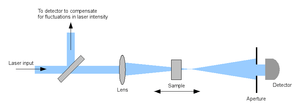Z-scan technique

In Nonlinear optics a z-scan measurement is used to measure the non-linear index  Kerr nonlinearity and the non-linear absorption coefficient Δα via the "closed" and "open" methods respectively. As nonlinear absorption can affect the measurement of the non-linear index the open method is typically used in conjunction with the closed method to correct the calculated value.
Kerr nonlinearity and the non-linear absorption coefficient Δα via the "closed" and "open" methods respectively. As nonlinear absorption can affect the measurement of the non-linear index the open method is typically used in conjunction with the closed method to correct the calculated value.
Closed Aperture Z-scan Technique
In this setup an aperture is placed to prevent some of the light from reaching the detector. The equipment is arranged as can be seen in the diagram. A lens focuses a laser to a certain point, and after this point the beam naturally defocuses. After a further distance an aperture is placed with a detector behind it. The aperture causes only the central region of the cone of light to reach the detector. Typically values of the normalised transmittance are between  .
.
The detector is now sensitive to any focusing or defocusing that a sample may induce. The sample is typically placed at the focus point of the lens, and then moved along the z axis a distance of  which is given by the Rayleigh length
which is given by the Rayleigh length  :
:

The thin sample approximation states that the thickness of the sample  must be less than the Rayleigh length
must be less than the Rayleigh length 
Open Aperture Z Scan technique
This method is similar to the above method, however the aperture is removed or enlarged to allow all the light to reach the detector. This in effect sets the normalised transmittance to S = 1. This is used in order to measure the non-linear absorption coefficient Δα. The main cause of non-linear absorption is due to Two-photon absorption.
Eclipsing Z-scan
This method is similar to the closed z-scan method, however the sensitivity of the system is increased by only looking at the outer edges of the beam by blocking out the central region. This is achieved by replacing the aperture with disks that block the central part of the beam. The method got its name from the way in which the light passes around the disk to the detector in a similar way to an Eclipse.
A further improvement to the Eclipsing Z-scan method is to add a lens behind the aperature so that the light is focussed onto the detector, this can also reduce the need for a larger detector.
External links
- Z-scan measurements of Optical Non linearities
- Z-scan measurement summary by Rüdiger Paschotta